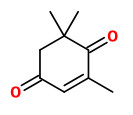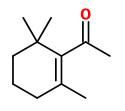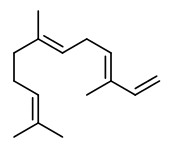Buddleja davidii Franch. - Scrophulariaceae (also placed in Loganiaceae)
大叶醉鱼草 da ye zui yu cao (chin.), butterfly bush, summer lilac, Schmetterlingsflieder, Sommerflieder
Shrub, native to China, naturalized and cultivated elsewhere as ornamental; leaves narrowly elliptic or ovate, abaxially tomentose or pubescent with stellate hairs; flowers fragrant, violet to dark purple, sometimes white, with an orange-yellow throat.
http://www.efloras.org/florataxon.aspx?flora_id=2&taxon_id=200017825
The flower scent collected using the dynamic headspace adsorption method and analysed by GC-MS showed 3-hydroxy-2-butanone (acetoin; 1.6%), hexanol (1.6%), 2-hydroxyheptan-3-one (2.5%), 3-hydroxyheptan-2-one (2.0%), benzaldehyde (4.9%), (E)-β-ocimene (2.1%), (E,E)-α-farnesene (20.0%), β-cyclocitral (2.0%), oxoisophorone oxide (10.1%), oxoisophorone (45.4%), and dihydrooxoisophorone (1.0%) as main components.
Minor components were e.g. hexyl acetate (0.9%), cis 3-hexenyl acetate (0.3%), phenylacetaldehyde (0.7%), benzyl alcohol (0.5%), cinnamic aldehyde cis/trans (0.2/0.3%), 2-phenylethanol (0.5%), cinnamic alcohol (0.1%), (Z)-β-ocimene (0,2%), lavandulol (0.2%), verbenone (0.1%), geranylacetone (0.1%), (Z,E)-α-farnesene (0.6%), farnesol (0.1%), 6-methyl-5-hepten-2-one (0.6%).
[Floral scents in butterfly‐pollinated plants: possible convergence in chemical composition., Andersson, S., Nilsson, L.A., Groth, I., Bergström, G., Botanical Journal of the Linnean Society, 140(2), 2002, 129-153]
Benzaldehyde, 2-phenyl ethanol, and benzyl alcohol were among the dominating compounds in B. davidii flower scent.
[Influence of flower odour compounds on oviposition of the horse chestnut leaf miner Cameraria ohridella (Deschka & Dimic)., Johne, A.B., Sprauer, S., Weißbecker, B., Schütz, S., Mitt. Dt. Ges. Allg. Angew. Entomol, Vol.14, 2006, 355-360]
„Flowers of the butterfly bush, Buddleja davidii Franch., are visited by butterflies as well as other insects. Night captures revealed also that moths visit butterfly bush flowers. Moths captured in traps over flowers included 12 species of Noctuidae, 6 species of Pyralidae, 2 species of Geometridae, and 1 tortricid species. The majority of moths trapped at these flowers were cabbage loopers, Trichoplusia ni (Hübner), and alfalfa loopers, Autographa californica (Speyer). Both males and females were captured at butterfly bush flowers. Additionally, butterflies, bees, wasps, flies, and other insects also were captured. Analysis of volatile compounds collected from air over clusters of butterfly bush flowers yielded the consistent presence of nine chemicals: benzaldehyde, 6-methyl-5-hepten-2-one, hexyl acetate, 4-oxoisophorone, (E,E)-α-farnesene, (Z)-cinnamaldehyde, dihydrooxoisophorone, β-cyclocitral, and oxoisophorone oxide. Emitted amounts of these floral odorants averaged 57 ng per h per floret or 21 μg per h per flower cluster (raceme). Five of those floral chemicals, benzaldehyde, 4-oxoisophorone, dihydrooxoisophorone, oxoisophorone oxide, and (E,E)-α-farnesene triggered antennal responses in cabbage looper moths, while benzaldehyde, oxoisophorone oxide, and 4-oxoisophorone also stimulated antennal responses in alfalfa looper moths. Some of these compounds may be attractants or co-attractants for moths and play a key role in locating flowers as nectar sources.“
[Odorants of the flowers of butterfly bush, Buddleja davidii, as possible attractants of pest species of moths., Guédot, C., Landolt, P.J., Smithhisler, C.L., Florida entomologist, Vol.91(4), 2008, 576-582]
„Floral scents of B. davidii were collected using dynamic headspace adsorption and identified with coupled gas chromatography and mass spectrometry. In total, 33 compounds were identified from the inflorescences of B. davidii. The identified scents were divided into five chemical classes based on their biosynthetic origin: irregular terpenes, monoterpenoids, sesquiterpenoids, fatty acid derivatives, and benzenoids. The scent profiles in all populations were dominated by few components, such as: 4-oxoisophorone, (E,E)-α-farnesene, and 1-octen-3-ol.“
[Inflorescence scent, color, and nectar properties of “butterfly bush”(Buddleja davidii) in its native range., Chen, G., Gong, W., Ge, J., Dunn, B.L., Sun, W., Flora-Morphology, Distribution, Functional Ecology of Plants, Vol.209(3), 2014, 172-178]
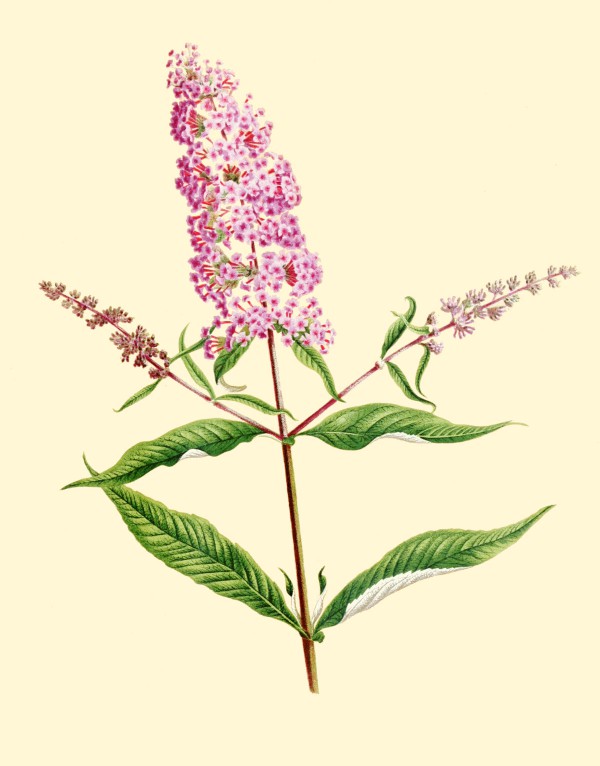
The garden. An illustrated weekly journal of horticulture in all its branches [ed. William Robinson], vol. 55: p. 428, t. 1227 (1899) [Miss Tisdall]
http://www.plantillustrations.org/species.php?id_species=162454
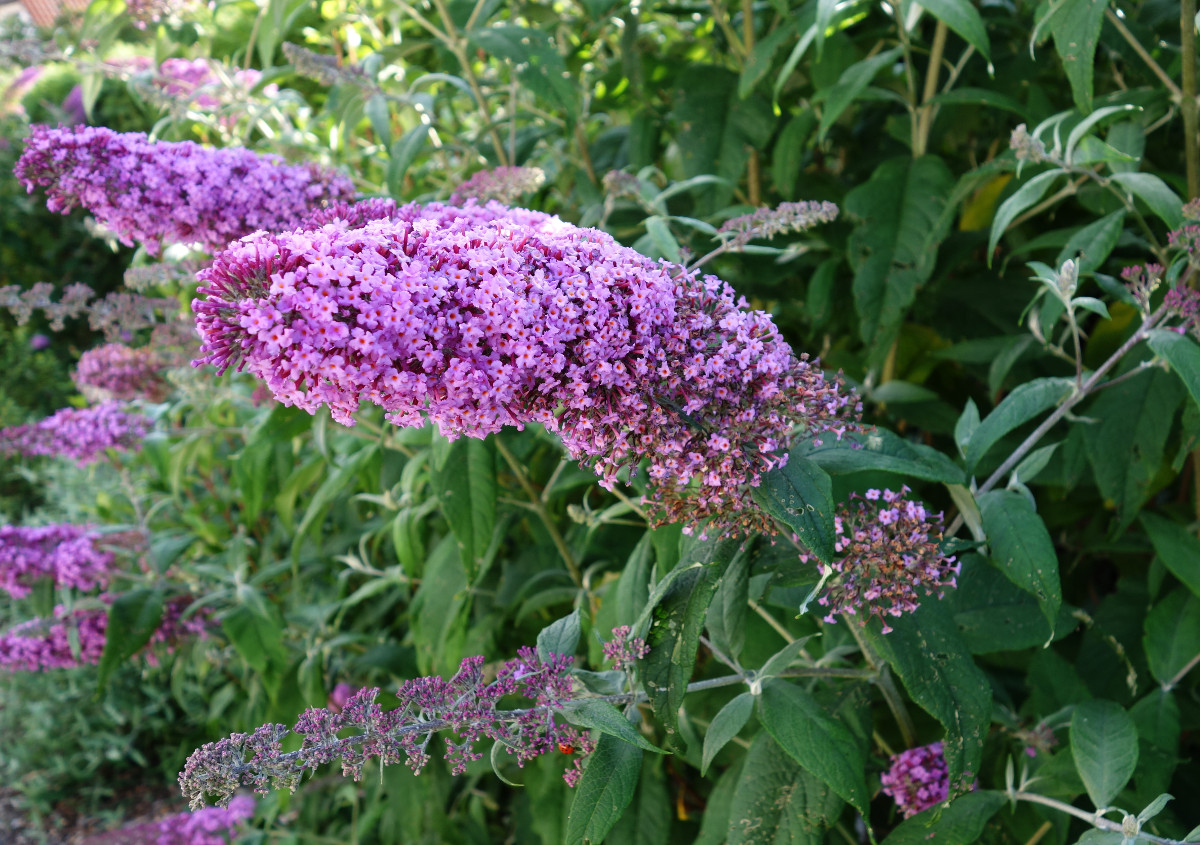
Buddleja davidii flowering, CC BY-SA 3.0, Author: Andreas Kraska


